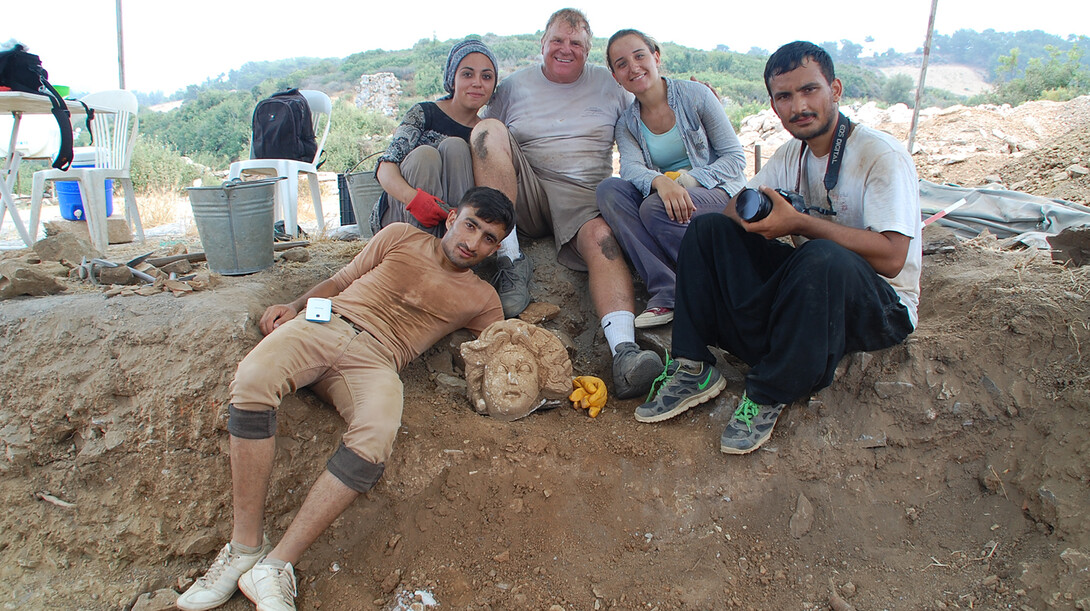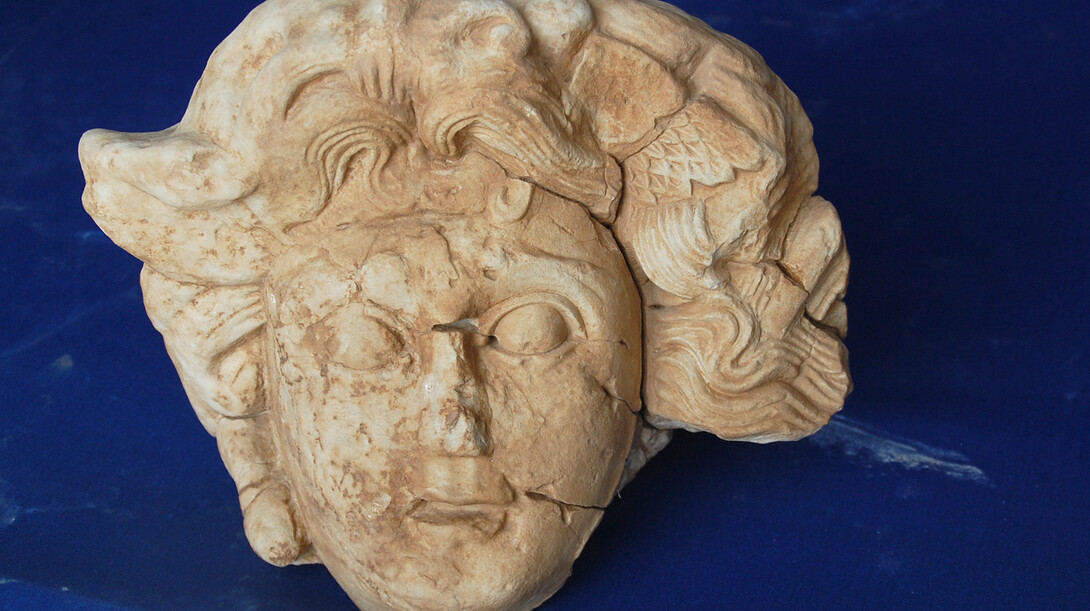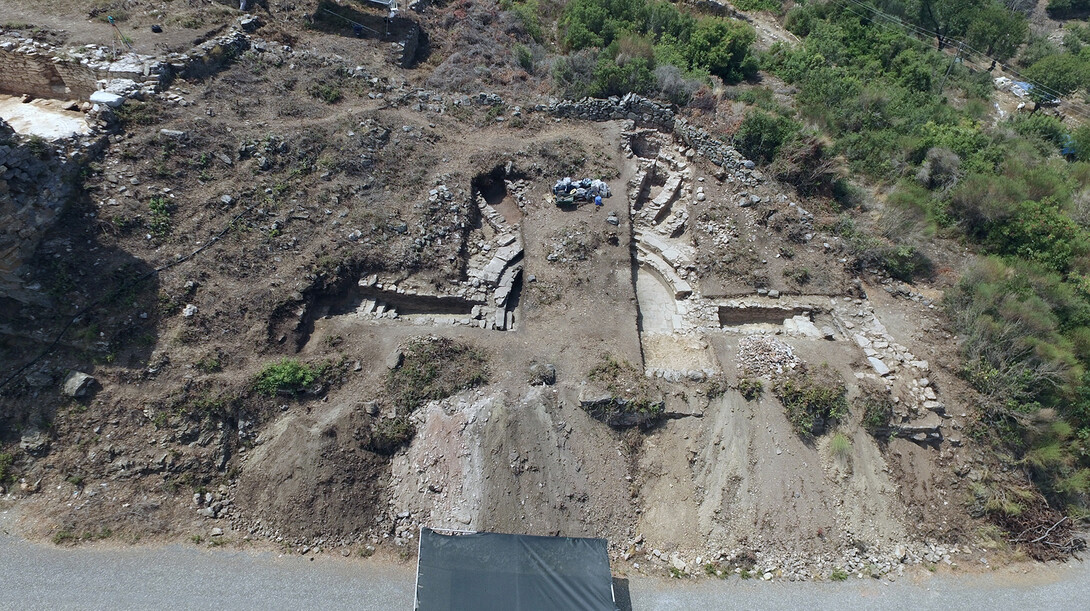
Antiochia ad Cragum, an ancient Roman city on Turkey’s southern coast, has yielded more of its secrets to an archaeology team led by the University of Nebraska-Lincoln.
A Medusa’s head, which once guarded a small temple or altar, was found in the rubble near a previously discovered 1,600-square-foot marble mosaic that dates to Roman times. Nearby, on the opposite side of what once was a grand Roman bath house, archaeologists uncovered part of the ruins of another building. Though full excavation will take place in the future, team members found enough to identify the building as a bouleuterion, or city council house.
The team, led by Michael Hoff, Hixson-Lied professor of art history at UNL, also has found the outlines of a basilica, the fourth and largest Christian church found so far in the city center; as well as evidence that a hilltop building they have dubbed the Acropolis was used as a Christian monastery during the Byzantine Empire.
The new discoveries offer clues to how the people of Antiochia lived as well as the religious and social changes that shaped their city. Yet the greatest mystery remains unanswered: Why was the city abandoned so many years ago, silenced beneath more than six feet of earth?
“Something happened,” Hoff said. “It’s possible that earthquakes damaged the city to a degree that people just decided to abandon it. Or it’s possible we can find archaeological evidence that people lived here until the arrival of the Seljuk Turks in about A.D. 1100.”
The Seljuk Turks defeated the Byzantine Empire in 1071, opening the way for the Turkish occupation of Anatolia, the peninsula between the Black Sea, the Aegean Sea and the Mediterranean Sea, where Turkey is located. The Turks forced people to leave other old Roman cities in the region, Hoff said.
Antiochia was established at about the time of Nero in the middle of the First Century and flourished during the height of the Roman Empire. By the fourth century, the area was a key site for the development of Christianity.
A typical city for its time, Antiochia ad Cragum is becoming more well known because of Hoff and his colleagues from Atatürk University in Turkey, Clark University in Massachusetts and the Peter Kiewit Institute at the University of Nebraska.
Graduate Ben Kreimer worked with the team to get a bird’s-eye view of the ancient city and its surroundings. Kreimer, an alumnus of the drone journalism laboratory at the College of Journalism and Mass Communications as well as the university’s summer field school in archaeology, flew a camera-equipped drone over the site, capturing images of key monuments and exploring areas that can’t be seen from the ground.
The archeologists seek to understand how the city evolved during nine or more centuries of existence.
Like 2013’s discovery of an Aphrodite statue’s head, the Medusa figure is evidence of Roman culture in a city once viewed by scholars to be too much of an outpost to be much influenced by Rome. Much evidence of Roman religion and culture likely was destroyed by radical Christians as they gained prominence in the region 17 centuries ago, Hoff said. Marble statuary, in particular, fell prey to the hammers and kilns of those who used the stone to make mortar.
“Unfortunately, ISIS followers were not the first ones to destroy classical buildings in the name of religion,” Hoff said. “It was the Christians who performed the first destruction of buildings, back in the late Roman and Byzantine periods. They wanted to remove pagan images because they were considered to be idolatrous. The Christians were extremely active at this site and they did a great deal of destruction.”
Medusa was a Greek mythological creature with serpents for hair and a gaze that turned living people to stone. People in ancient times adopted Medusa’s head as a protective symbol to ward off intruders. Slightly larger than life-sized, the Medusa head was found by some Turkish students among fragments near the foundation of a small building.
Philip Sapirstein, a Nebraska assistant professor of art history who studies ancient Greek architecture using 3-D computer modeling, examined the Medusa find. Back in the United States, Sapirstein used 3-D computer modeling to piece together images of the head and five marble fragments found near it.
Hoff said the building appears to be a temple or an altar, though it is not known for certain because all that remains are its marble foundations. The monument is next to an open-air plaza with a swimming pool that stands outside a Roman bath house. The archeological team found one of the largest mosaics in the region when it excavated the plaza in 2012.
The teams used chain saws to remove thorny brush that covered a bowl-shaped depression behind the bath house. After removing more than four feet of earth in a test trench, the archeologists realized they had found the city’s seat of government. They uncovered a semi-circular marble bench to seat dignitaries that faced a platform and orchestra area paved in marble. Behind the bench were two radiating sets of marble stairs, which likely led to grandstand seats.
The proletariats’ seats probably were made of wood and no longer exist. However, the team recovered about 20 pounds of ancient nails and hundreds of roof tiles scattered in the area, evidence of the building’s former structure.
They will continue excavating the bouleuterion next year.
“That was one of our best finds,” Hoff said. “This was truly the heart of the ancient city.”









